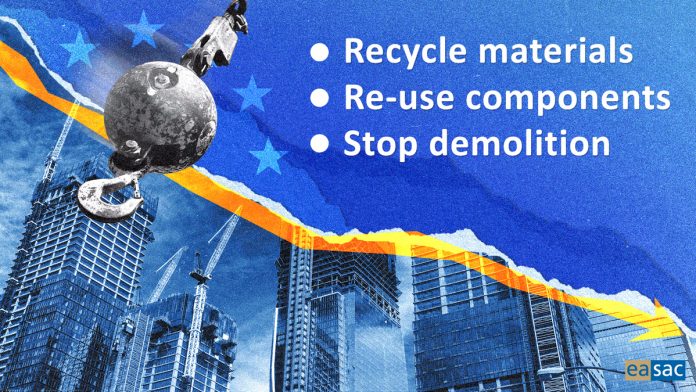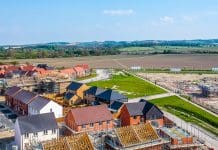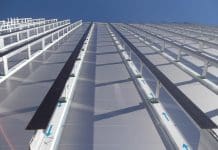A new report from the European Academies Science Advisory Council argues that a fundamental policy changes are needed if we are to successfully tackle greenhouse gas emissions from the built environment, construction processes and the supply of building products. Dr William Gillett and Professor Brian Norton take a look
A recent report by the European Academies Science Advisory Council (EASAC) explains that while policymakers have long focused on reducing the greenhouse gas (GHG) emissions caused by operating buildings, this is only part of the story.
Embodied GHG emissions are produced during the manufacture of construction materials, notably cement and steel so, to avoid shooting yourself in the foot when renovating existing buildings, it is also important to limit the embodied GHG emissions caused by your renovations.
The report advises EU policymakers to update EU legislation using an integrated approach to phase out fossil fuels, increase renewable energy supplies and reduce cumulative (operating plus embodied) GHG emissions from buildings.
Promote health and wellbeing
Most of the buildings in use today will still be operating in 2050 and only around 1% of the European building stock is being renovated annually, so to achieve net-zero carbon emissions from buildings by 2050, renovation rates must be increased by a factor of about three.
One way to encourage more deep energy renovations is to promote the health and wellbeing benefits which they offer to building occupants, as well as their GHG emission reductions, because they can improve air quality, increase access to daylight, and stop draughts and overheating.
Limit embodied GHG emissions per m2 of floor area
GHG emissions from the construction industry and its materials and component supply chains must be reduced because renovating a building to reduce its operating energy consumption makes little sense if there is no control of the carbon-intensive materials and components used for the renovation.
To tackle this problem, the report argues that legislation should put a limit on the embodied GHG emission per m2 of floor area that is brought into a building when it is constructed or renovated. This will require improved access for building owners and professionals to certified data on the embodied GHG emissions of building materials and components, as well as on the energy and GHG emission performance of new and renovated buildings.
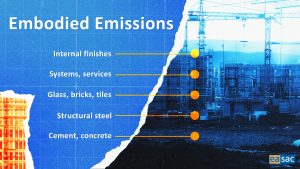
Nearly zero energy building (NZEB) concept is outdated
For the past 10-15 years, European policies have adopted the concept of “Nearly-zero energy buildings” (NZEB) with a focus on reducing the consumption of energy used to provide comfort to building occupants.
According to EASAC, this notion is outdated because there are only about 10 years left before the door closes for limiting global warming to less than 1.5C. Instead, the indicator to be used now for assessing the climate impact of a new building or renovation should be cumulative GHG emissions, including both the embodied emissions produced by the building works and the operating emissions produced by the building in the years following those works.
Buildings should be designed to be disassembled and recycled at end of their lifetime
The report points out that most of the built environment is still designed using a linear take-make-consume-dispose approach. Transitioning to a circular economy would not only help to reduce resource consumption and carbon footprint, but it would also address the waste problem.
Many building materials can be reused, recycled and recovered. Buildings should therefore be designed to be easily disassembled so that their materials and components can be recycled and reused when they are deeply renovated or eventually demolished.
Renovate – don’t demolish!
Renovating existing buildings must be at the heart of decarbonisation strategies, the scientists argue. It’s important to consider the reuse of existing buildings rather than replacing existing buildings with new ones, because there is a lot of embodied carbon in a building structure, especially in the concrete and steel. With today’s technologies and digitalised processes, renovating has become a lot easier and more sustainable, so it makes sense to stop the current practice of knocking down existing structures and then rebuilding from scratch.
EU renovation wave: More than 90,000 renovated homes per week until 2050
In 2020, the European Commission presented a Renovation Wave strategy to reduce the emissions from European buildings with “poor” energy performance. This would require around 146 million renovations of residential buildings in only 30 years, or more than 90,000 renovations per week.
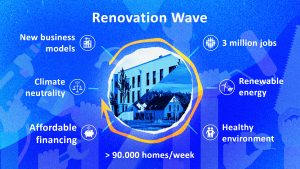
Key roles for cities and regional authorities
While the messages in the report are mainly targeted at EU and national policymakers, it is also made clear that cities, regional authorities and urban planners can have tremendous influence on GHG emissions.
They can stimulate the construction and renovation of nearly zero GHG emission neighbourhoods with integrated energy and transport systems, and require the provision of adequate green spaces. They can facilitate the upgrading of existing district heating and cooling systems or build new ones with optimised use of renewable energy, including PV, heat pumps, solar and geothermal heating, waste heat and natural cooling.
In addition, they are particularly well-placed to oversee renovations of social housing and can subsidise the deep renovation of private housing where necessary to reduce energy poverty.
Grants, incentives and financing
Public funding will not be enough to pay for all the renovations needed. Instead, it should be used to provide grants and incentives to trigger, leverage and de-risk private financing for deep energy-related building renovations.
Public authorities should work with the financing industry (banks and investors) to make renovation financing more affordable for private investors and to lift underprivileged vulnerable groups out of energy poverty.
Challenges and opportunities for Europe’s building industry
The report concludes that Europe’s building industry should be modernised. Its construction methods should be updated and it should adopt more circular business models.
On this basis, the proposed renovation wave could create more than 3 million new jobs, and many of these could be high quality jobs. Moreover, Europe’s building workforce could benefit from a better gender balance, especially if construction methods are modernised and the potential for using prefabricated building components is realised.
The EASAC report is freely available for downloading from the EASAC website. It was discussed with two members of the European Parliament and experts from the European Commission, the European Investment Bank, EU-ASE, Housing Europe, and the industry at a webinar on 2 June.
Dr William Gillett
Director, EASAC Energy Programme
European Academies Science Advisory Council
Tel: +49 345 4723 9833
Twitter: EASACnews
Prof Brian Norton
Head of energy research
Tel: +353 (0)21 2346177
Twitter: @tyndallinstitut
LinkedIn: Tyndall National Institute
YouTube: Tyndallweb


